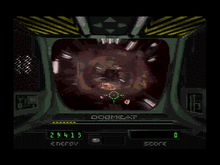Sewer Shark
| Sewer Shark | |
|---|---|
 | |
| Developer(s) | Digital Pictures |
| Publisher(s) | Sony Imagesoft |
| Platform(s) |
Sega CD 3DO |
| Release date(s) |
|
| Genre(s) | FMV rail shooter |
| Mode(s) | Single-player |
Sewer Shark is a first-person rail shooter video game, and is the first on a home console to use full-motion video for its primary gameplay. It was originally slated to be the flagship product in Hasbro's Control-Vision video game system, which would use VHS tapes as its medium. However, Hasbro cancelled the Control-Vision platform, and Digital Pictures later developed the game for the Sega CD expansion unit. Sewer Shark is one of the first titles for the Sega CD, and was later bundled with Sega CD units, making it one of the best-selling games for the system. It was later ported and released for the 3DO in 1994. A port was also planned for the SNES-CD, but that system was cancelled.
Plot
Sewer Shark takes place in a post-apocalyptic future where environmental destruction has forced most of humanity to live underground. The player takes on the role of a rookie pilot in a band of "sewer jockeys", whose job is to exterminate dangerous mutated creatures to keep a vast network of sewers clean for "Solar City", an island paradise from which the evil Commissioner Stenchler (Robert Costanzo) gives his orders and critiques. The player's copilot, Ghost (David Underwood), evaluates the player's performance throughout the game, while a small robot named Catfish (voiced by Robert Weaver) scouts ahead and gives directions. The player is later assisted by Falco (Kari G. Peyton), a female jockey who believes that there is a hidden route to the surface. Falco is later captured by Stenchler, who threatens to turn her into one of his mindless minions. This plot is thwarted when Ghost and the player reach Solar City.
Gameplay

The objective of Sewer Shark is to travel all the way from the home base to Solar City without crashing or running out of energy, and while maintaining a satisfactory level of performance as judged by Ghost and Commissioner Stenchler. As in other rail shooters, the ship mostly flies itself, leaving the player to shoot ratigators (mutant crosses between rats and alligators), bats, giant scorpions and mechanical moles. Along the way, Catfish periodically gives the player a series of numerical coordinates corresponding to directions that the player must follow at a set of upcoming intersections. If the player takes a wrong turn or misses a turn, he or she may crash into a door, grate or wall, ending the game. (Later in the game, Catfish is replaced by a bird-like "crazy lookin' thing", which visually guides the player through the sewers.)
The ship has a limited amount of energy, which depletes slowly during flight and while firing. (Scorpions also rob the ship of energy if the player fails to shoot them down.) This energy can be fully replenished at recharge stations found at key points through the sewers. In later areas, the ship will also encounter occasional pockets of hydrogen that the player must have Catfish detonate to pass through safely.
At certain times through the game, Ghost and/or Stenchler will interrupt the player to give direct feedback on his or her performance. If the player is doing well, he or she is allowed to continue and is occasionally given a promotion in the form of a new call sign. A poor performance will eventually cause the game to end. As the player gains Ghost's trust, the extent of Stenchler's hostility toward the player increases until he finally tries to destroy the ship directly.
Sewer Shark is often referred to as an interactive movie due to its use of full-motion video to convey the game's action, and the navigation aspect of the game is frequently compared to Dragon's Lair, since turns are gates that the player must pass through to continue playing.
Production
The game originated on the VHS-based Control-Vision video game console.[1] This tape contains four separate video streams were interleaved on the tape, allowing the hardware to switch between video streams to, for example, show a turn being taken or ignored, along with the outcome of that decision (crashing into a wall or continuing unimpeded). Digital Pictures maintained this multiple-stream approach on the Sega CD platform, presenting all of the game's video as one continuous stream to minimize seek time on the CD. To work within the console's limitations, the developers wrote a custom video codec to highly compress all four streams so they could be read in realtime from the CD. This codec was also used in Night Trap and the Make My Video series, and an improved version was later used in Prize Fighter.
The video footage in Sewer Shark was directed by visual effects artist John Dykstra.
According to Digital Pictures president Tom Zito, Sewer Shark cost $3 million to develop.[2]
Reception
Sewer Shark is one of the Sega CD's best-selling games, with more than 100,000 units sold prior to having been bundled with the system.[3]
The game is on the Associated Press list of top ten video games from 1993. They called it "bizarre and wildly entertaining" and a must-have game for all Sega CD owners.[4]
References
- ↑ Plunkett, Luke (March 28, 2011). "Only In The 80's Would They Put Video Games On A VHS Tape". Kotaku. Retrieved December 26, 2015.
- ↑ Zito, Tom (March 1995). "Dispatches". Next Generation. Imagine Media (3): 106–7.
- ↑ "Sega Packs Sewer Shark with New Sega CD". GamePro (52). IDG. November 1993. p. 261.
- ↑ Schiffmann, William (January 9, 1994). "Video game review: The best of 1993". Associated Press. The Argus-Press.